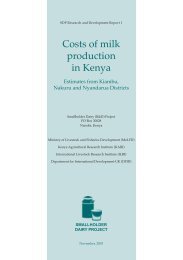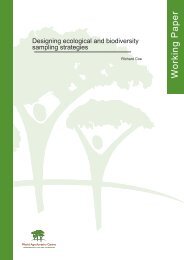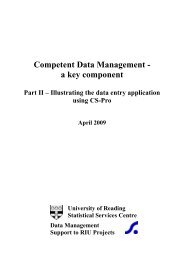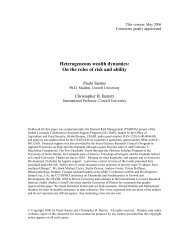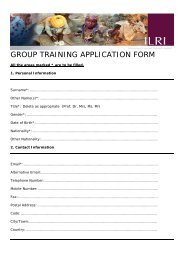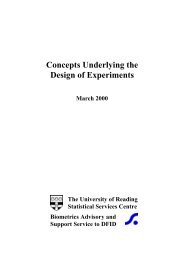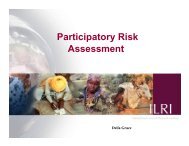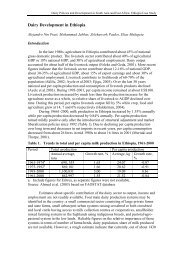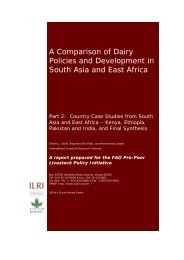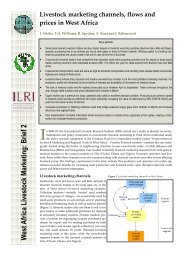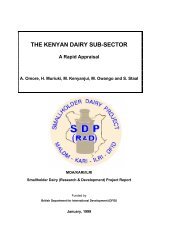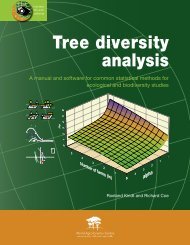One issue that relates particularly to cattle production systems is that <strong>of</strong> shift<strong>in</strong>g cultivation. It isestimated that about 100,000 ha <strong>of</strong> primary forest and 300,000 ha <strong>of</strong> secondary forest are each year degradedby shift<strong>in</strong>g cultivation. To reduce this trend, and <strong>in</strong> order to <strong>in</strong>crease upland agricultural productivity, morepermanent forms <strong>of</strong> agriculture are be<strong>in</strong>g considered, <strong>in</strong> which cattle are an important component. The strategycalls for <strong>in</strong>creas<strong>in</strong>g the availability <strong>of</strong> feed from fallows by <strong>in</strong>corporat<strong>in</strong>g legumes as well as the development<strong>of</strong> more efficient systems <strong>of</strong> feed<strong>in</strong>g. However, much will depend on labour availability and use, and theproduction <strong>of</strong> sufficient feed to ensure improved animal performance. The strategy to stabilise shift<strong>in</strong>gcultivation is l<strong>in</strong>ked with the aim <strong>of</strong> settl<strong>in</strong>g about 20,000 families or about 3000 families each year up to theend <strong>of</strong> the century.Non-rum<strong>in</strong>ants, except those <strong>in</strong> peri-urban areas, are kept ma<strong>in</strong>ly <strong>in</strong> extensive or semi-<strong>in</strong>tensive systems.On small farms, they scavenge and are also fed kitchen wastes. In the more <strong>in</strong>tensive systems, wherenon-rum<strong>in</strong>ants are conf<strong>in</strong>ed, rice bran is the ma<strong>in</strong> concentrate feed. Unlike Vietnam, <strong>in</strong>tegratedcrop–animal–aquaculture systems are not common, although the government is encourag<strong>in</strong>g thisdevelopment.Feed resourcesRum<strong>in</strong>ants graze native pastures on roadsides, wasteland, conservation bunds, and <strong>in</strong> rice stubble. Dur<strong>in</strong>gthe wet season when crops are planted, the animals are conf<strong>in</strong>ed, tethered or taken to forest areas. <strong>Crop</strong>residues (ma<strong>in</strong>ly rice straw) are fed dur<strong>in</strong>g the dry season and some rice bran. Rice bran is also very importantfor pigs and poultry as an energy and prote<strong>in</strong> source.The country is endowed with native pasture graz<strong>in</strong>g areas and out <strong>of</strong> a total <strong>of</strong> 8.5 million ha, 2.4, 0.4and 5.7 million ha are found <strong>in</strong> the lowlands, plateaux and upland areas, respectively. The use <strong>of</strong> these areasis, however, uncontrolled and considerable opportunities exist to control stock<strong>in</strong>g rate to <strong>in</strong>creaseproductivity. In Xieng Khouang Prov<strong>in</strong>ce, animals graze ma<strong>in</strong>ly on native grasses such as Themeda spp whichare burnt regularly. In the dry season, animals are supplemented with untreated rice straw or graze rice stubble.Over the last 20 years, various projects have resulted <strong>in</strong> the selection <strong>of</strong> improved pastures. In Xieng KhouangProv<strong>in</strong>ce, these <strong>in</strong>clude Andropogon gayanus, Napier grass, Paspalum plicatulum, Panicum maximum,Brachiaria ruziziensis, B. humidicola, Setaria sphacelata and the legumes Lotononis ba<strong>in</strong>esii, Chamaecristarotundifolia, Stylosanthes guianensis, Macrotyloma axillare and Desmodium <strong>in</strong>tortum. The use <strong>of</strong>multipurpose trees is not very common.<strong>Animal</strong> health and diseases<strong>Animal</strong> diseases are an important constra<strong>in</strong>t to production, and the problems <strong>in</strong>crease with decreas<strong>in</strong>gaccessibility <strong>of</strong> veter<strong>in</strong>ary services. Small farmers <strong>in</strong> the more remote rural areas are most affected. For bothcattle and buffaloes, the most serious problems are foot-and-mouth disease and haemorrhagic septicaemia.Large rum<strong>in</strong>ants also suffer from anthrax, blackleg, brucellosis and fascioliasis (Campbell 1992). Theproblem <strong>of</strong> foot-and-mouth disease is exacerbated by the illegal movement <strong>of</strong> large rum<strong>in</strong>ants across theborders, especially with Thailand. Sw<strong>in</strong>e fever <strong>in</strong> pigs and Newcastle disease <strong>in</strong> chicken are widespread.Phosphorus deficiency is also prevalent <strong>in</strong> several prov<strong>in</strong>ces, but can be overcome with the use <strong>of</strong> bone mealsupplements. Improved diagnostic methods, and the <strong>in</strong>creased use <strong>of</strong> vacc<strong>in</strong>es and strategies to control thesediseases are required. The FAO has been active <strong>in</strong> support<strong>in</strong>g animal health <strong>in</strong> the Lao PDR through severalprogrammes, <strong>in</strong>clud<strong>in</strong>g the establishment <strong>in</strong> 1980 <strong>of</strong> a National Institute <strong>of</strong> Vacc<strong>in</strong>e <strong>Production</strong> at Nang Teng.Currently, about seven types <strong>of</strong> vacc<strong>in</strong>es are produced, which are adequate to meet the needs <strong>of</strong> the country.Some vacc<strong>in</strong>es have been supplied to neighbour<strong>in</strong>g Cambodia. Regular vacc<strong>in</strong>ation is undertaken by theDepartment <strong>of</strong> <strong>Livestock</strong> and Veter<strong>in</strong>ary Services (DLVS), with the assistance <strong>of</strong> village veter<strong>in</strong>arians andfarmers, but <strong>in</strong>adequate equipment and limited expertise at village level <strong>of</strong>ten constra<strong>in</strong> the effectiveness <strong>of</strong>this programme.The Australian Centre for International Agricultural Research (ACIAR) recently <strong>in</strong>itiated an animalhealth project <strong>in</strong> the country. The ma<strong>in</strong> aims <strong>of</strong> this programme are to develop field and laboratorymethodologies for the diagnosis and control <strong>of</strong> priority diseases; to undertake epidemiological studies <strong>in</strong>
village production systems; to study and validate the field effectiveness <strong>of</strong> the Laotian sw<strong>in</strong>e fever vacc<strong>in</strong>e,to study disease resistance <strong>in</strong> local and exotic breeds; and to transfer appropriate technology from theAustralian <strong>Animal</strong> Health Laboratory to the Lao PDR.Socio-economic aspectsSeveral socio-economic surveys have been undertaken by various agencies <strong>in</strong> different parts <strong>of</strong> the country.In the uplands, where shift<strong>in</strong>g cultivation is practised, animals are important for <strong>in</strong>come generation and areperceived as capital assets. The contribution <strong>of</strong> animals to total farm <strong>in</strong>come is considerable, and theimportance <strong>of</strong> manure for crop cultivation is recognised. However, the application <strong>of</strong> manure is variable, andis dependent on the number <strong>of</strong> animals owned, alternatives for use, and the area <strong>of</strong> the cultivated crop.Accord<strong>in</strong>g to Fujisaka (1990), the order <strong>of</strong> priority for manure application is rice seedbeds, upland cash cropsand small fields <strong>of</strong> rice. Aga<strong>in</strong>, <strong>in</strong> order <strong>of</strong> importance, manure is distributed evenly to small plots, to alternateplots each year, to less productive parts <strong>of</strong> large fields, and to middle terraces where drought and flood risksare lowest.Detailed surveys (DLVS 1993) <strong>in</strong> ra<strong>in</strong>fed areas <strong>in</strong> six prov<strong>in</strong>ces, 18 villages and six districts <strong>in</strong>volv<strong>in</strong>g305 households <strong>in</strong>dicated that farmers on the plateaux kept 9.9 head <strong>of</strong> cattle per household compared to 4.4and 7.2 head per household <strong>in</strong> the lowland and upland areas. The contribution <strong>of</strong> cattle to total farm <strong>in</strong>come<strong>in</strong> the lowlands, plateaux and uplands was 56, 46 and 56%, respectively. The survey also identifiedsocio-economic and technical constra<strong>in</strong>ts to production.Constra<strong>in</strong>ts to productionThere are a number constra<strong>in</strong>ts to animal production. Firstly, the most important factor is animal diseases.At the small-farm level, mortality rates are <strong>in</strong> excess <strong>of</strong> 60%, particularly for non-rum<strong>in</strong>ants. This is due topoor veter<strong>in</strong>ary <strong>in</strong>puts and services. Secondly, animal performance is limited by nutritional factors whichvary depend<strong>in</strong>g on species. Generally, for rum<strong>in</strong>ants, availability <strong>of</strong> feed is not a major problem, but quality<strong>in</strong> the dry season and efficiency <strong>of</strong> use are constra<strong>in</strong>ts. For non-rum<strong>in</strong>ants, prote<strong>in</strong> feeds are <strong>in</strong> limited supplyand <strong>in</strong>creas<strong>in</strong>g their availability is a major challenge. For both groups <strong>of</strong> animals, supplementation strategiesare needed. Thirdly, there is a shortage <strong>of</strong> tra<strong>in</strong>ed personnel to support the generation and transfer <strong>of</strong>technology, and a greater need for farmers to participate <strong>in</strong> research plann<strong>in</strong>g. As <strong>in</strong> Cambodia and Vietnam,tra<strong>in</strong><strong>in</strong>g as a component <strong>of</strong> <strong>in</strong>stitution build<strong>in</strong>g will be essential. The Lao-IRRI Project is <strong>in</strong>volvedsignificantly <strong>in</strong> the tra<strong>in</strong><strong>in</strong>g process for rice. F<strong>in</strong>ally, smallholders on isolated farms have poorcommunications and little or no access to credit facilities to support new developments.A feature <strong>of</strong> the work with improved forages has been the absence <strong>of</strong> the animal from the studies andan emphasis on plant selection rather than utilisation. In addition to the fallow period <strong>in</strong> upland rice, otheropportunities are available <strong>in</strong> rice-based systems for the plant<strong>in</strong>g <strong>of</strong> improved forages, e.g. the establishment<strong>of</strong> liv<strong>in</strong>g fences <strong>of</strong> multipurpose trees (farmers use bamboo fenc<strong>in</strong>g around ra<strong>in</strong>fed lowland rice fields) andthe sow<strong>in</strong>g <strong>of</strong> improved species on bunds and terraces <strong>in</strong> ra<strong>in</strong>fed lowland rice production. Emphasis on forageevaluation has been on perennial species, but opportunities exist for the <strong>in</strong>ter-cropp<strong>in</strong>g or relay-cropp<strong>in</strong>g <strong>of</strong>annual species.MalaysiaEnvironment and cropp<strong>in</strong>g systemsMalaysia has a land area <strong>of</strong> 336,700 km 2 . Although rice is a major crop, priority systems throughoutPen<strong>in</strong>sular Malaysia, Sabah and Sarawak are based on rubber, oil palm and coconut. There are over 2.2 millionha <strong>of</strong> oil palm, 1.8 million ha <strong>of</strong> rubber (85% on Pen<strong>in</strong>sular Malaysia) and approximately 1.0 million ha <strong>of</strong>coconut, together cover<strong>in</strong>g almost 60% <strong>of</strong> the total agricultural land <strong>in</strong> Malaysia. In addition, there are 163,000ha under fruit orchards, 34% <strong>of</strong> which are durian. Smallhold<strong>in</strong>gs, <strong>of</strong> which the majority are
- Page 2 and 3:
Affiliation of Authors:Dr C. Devend
- Page 4 and 5:
6.Strategyfor researchJustification
- Page 7 and 8:
AcknowledgementsThe International L
- Page 9 and 10:
esearch opportunities appropriate t
- Page 11 and 12:
Table 1.Animal populations and meat
- Page 13 and 14:
Introduction2. Characterisation and
- Page 15 and 16:
Figure 2. Sub-humid tropics and sub
- Page 17 and 18:
Table 3.Human and animal population
- Page 19 and 20:
Table 5. Rice-growing environments
- Page 21 and 22:
Multiple upland annual crop systems
- Page 23 and 24: Table 6. Continued.Country Importan
- Page 25 and 26: It should be noted that, compared w
- Page 27 and 28: Table 8.CountryCambodiaChinaIndones
- Page 29 and 30: of non-renewable fossil fuels and t
- Page 31 and 32: Overview of researchThere was a sur
- Page 33 and 34: • Identification of alternative c
- Page 35 and 36: Various animal production systems t
- Page 37 and 38: Presently, much of the vegetable pr
- Page 39 and 40: Table 10. Summary of the main socio
- Page 41 and 42: Table 11. Institutions and organisa
- Page 43 and 44: 3. In the ASEAN sub-region, inadequ
- Page 45 and 46: Table 12. Continued.SituationsPract
- Page 47 and 48: 6. Strategy for researchJustificati
- Page 49 and 50: Table 13. Priorities for research a
- Page 51 and 52: VietnamResearch capacity in NARS is
- Page 53 and 54: CRIFC (Central Research Institute f
- Page 55 and 56: IAS. 1995. Proceedings of the Works
- Page 57 and 58: Systems of sub-Saharan Africa. Volu
- Page 59 and 60: or waterlogged in the wet season an
- Page 61 and 62: Table A1. Important diseases of ani
- Page 63 and 64: • Increased cropping intensities,
- Page 65 and 66: the animal output came from pigs al
- Page 67 and 68: 18-21° North, with an average rain
- Page 69 and 70: In the Nusa Tenggara islands, signi
- Page 71 and 72: Women work 11.5 h/day on average co
- Page 73: Various Australian forage projects
- Page 77 and 78: The availability of feed in rubber
- Page 79 and 80: of the Ayeyarwady and Sittang river
- Page 81 and 82: Constraints and opportunitiesInadeq
- Page 83 and 84: gaining in importance, and signific
- Page 85 and 86: Table A3. Characterisation of crop-
- Page 87 and 88: Table A4. Interventions in crop-ani
- Page 89 and 90: Table A4. Continued.Project TitleGo
- Page 91 and 92: otations are practised, and there a
- Page 93 and 94: such as abortion. Vaccination cover
- Page 95 and 96: large areas of forests (3.4 million
- Page 97 and 98: Table A6. Some animal diseases repo
- Page 99 and 100: Appendix IIItineraryThe Philippines
- Page 101 and 102: 26 November 1996 am Visit to small
- Page 103 and 104: Appendix IIIList of persons metPhil
- Page 105 and 106: Mr Chhiv Nan, Acting Director, Depa
- Page 107 and 108: Dr U Maung Ngint, Managing Director
- Page 109: List of acronymsAARDACIARADBAEZAIBP



